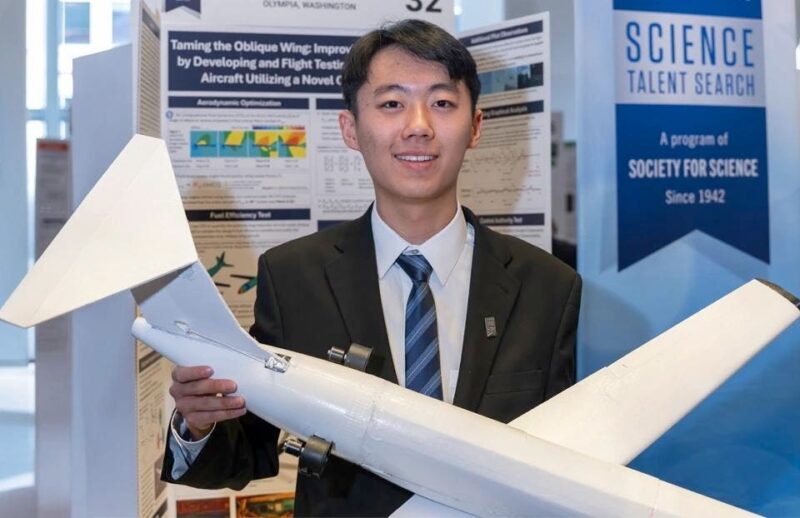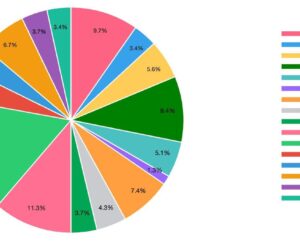An 18-year-old from Olympia, Washington, has just taken a significant step toward transforming the way we think about aviation. Kevin Shen’s new take on oblique-wing design not only achieves a higher level of efficiency but has also earned him $70,000 in a prestigious science competition.
In aeronautics, an oblique-wing design pivots the wing of an aircraft to angle the body and reduce overall drag. This increases fuel efficiency; however, it also makes the airplane hard to control. Shen was able to design his own plane and program a flight computer that stabilized the plane, using 9.2% less fuel. Organizations like NASA abandoned oblique-wing designs in the past. However, with this leap forward, Shen could be helping shape the future of aviation.
The Journey- Turning Curiosity Into Creation
Before he was building model planes and winning renowned science competitions, Shen was drawing inspiration from online science icons like Bill Nye, Mark Rober, Flite Test, Veritasium, Kurzgesagt, Vsauce, and more.
“When it comes to who has had the most impact on me as a hero, it’s not a Nobel-winning scientist, but an online one,” Shen said. “They make STEM accessible to mass audiences and inspire them to be interested in and value science in a fun, engaging way.”
These icons challenged Shen at a young age and inspired him to pursue a career in STEM. Soon, he was building and flying model airplanes and experimenting with unconventional designs, including oblique wings. He saw the potential in something NASA had shelved decades earlier. Shen theorized that a computer-assisted flight control system could overcome the design’s shortcomings. He got to work and soon had a working model built from dollar-store foam board, 3D-printed parts, hot glue, and scratch-building techniques.
“My favorite part of the project was physically building the oblique-wing model airplane. After literally hundreds of hours of literature review, design optimization, fluid simulation, computer modeling, and programming, seeing all my hard work come together into a physical airplane validated my effort. I enjoy working with not just my mind, but also my hands, so finally getting to assemble something I had designed in my head was incredibly satisfying,” said Shen.
His experience was not without setbacks and challenges. After each failed test and subsequent plane crash, he had to hike across the testing field to collect scattered parts. Watching hours of hard work destroyed in seconds was disheartening, but he knew failure is an integral part of research—and often the best teacher.
What is Oblique-wing design, and how does it work?
Also known as a slewed wing, an oblique-wing design allows an aircraft’s wings to rotate around a center pivot point. The aircraft can fly with a regular straight-wing configuration but can also rotate the wings, sweeping one tip forward and the other backward. Changing the wing angle reduces drag at higher speeds.
How Oblique Wings Work: From straight wings at takeoff to fully swept oblique wings at supersonic speeds, each position balances lift, drag, and control—unlocking efficiency but demanding advanced flight systems.”
Kander10 Designs LLC
In the 1970s, NASA conducted research on oblique-wing designs and demonstrated their aerodynamic efficiency. Unfortunately, the project was abandoned due to flight control issues. Decades later, Kevin Shen developed and programmed an onboard flight computer to address those challenges, achieving a 9% reduction in drag and significantly lowering both fuel consumption and carbon emissions.
Winning at the Regeneron Science Talent Search 2025 and beyond.
Earlier this year, Shen submitted his design to the 2025 Regeneron Science Talent Search. He competed against nearly 1,900 other high school students in the US, earning a spot as one of the 40 finalists, advancing to a week-long competition in Washington, DC, and winning 7th place, along with a $70,000 prize.
Shen was overwhelmed by the results and stated, “When I entered the competition, I thought I had such a small chance that I wasn’t even planning on applying—it was only when a previous finalist persistently encouraged me to give it a try that I applied last minute”.
His project has also received $25,000 from the Davidson Fellows program and $5,000 from the 1st Grand Award at ISEF. Adding all three awards together yields a total of $100,000, which he says will go toward future educational costs.
The Future of Shen’s Oblique-Wing Design
Kevin Shen has already proven his oblique-wing aircraft flies more efficiently than earlier attempts, but he’s just getting started. If he had more time and resources, he says the next step would be full autonomy. Right now, his flight computer assists the aircraft but doesn’t control it entirely. Making the plane fully autonomous would open the door to richer, more precise data—insights that could accelerate the design’s evolution and take it to the next level.
As for what comes next, Shen is pragmatic but ambitious. He faces limited resources at home, but he views college and a future career as his chance to scale up. His dream is to build bigger, safer, and more advanced oblique-wing planes capable of redefining efficiency in aviation. For now, the project stands as a proof of concept—but in the years ahead, it could be much more.









